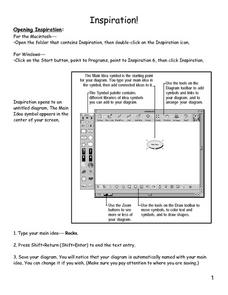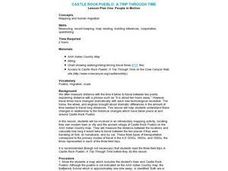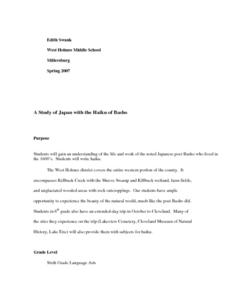NOAA
Importance of Deep-Sea Ecosystems – Chemists with No Backbones
Marine invertebrates offer us many new options for developing pharmaceutical drugs, such as w-conotoxin MVIIA, which is extracted from the cone snail and is a potent painkiller. The lesson encourages scholars to research various types of...
Science Matters
Fault Formations
The San Andreas Fault moves about two inches a year, approximately the same rate fingernails grow—crazy! The third lesson in the series allows for hands-on exploration of various fault formations. Through the use of a Popsicle stick,...
University of Virginia
The Songs in Uncle Tom's Cabin
Experience Harriet Beecher Stowe's Uncle Tom's Cabin in an innovative, musical way. A list of audio links leads class members to spirituals from the novel, such as "Die in the Field," "The Wings in the Morning," and "Blow Ye the Trumpet."
It's About Time
Mass Extinction and Fossil Records
The focus of a fossil-based lesson uses graphs and charts that allow young paleontologists to make inferences about events of mass extinction. They must apply their previous knowledge about fossil records in this final lesson of the...
Curated OER
Inspiration!
Students create a diagram based on rocks using a computer program. They use the program to put their thoughts in order and to have a sheet to reference to.
Curated OER
The Rock Pool
Third graders use number sense and appropriate problem solving techniques to solve the assigned problems. They write out the solutions to the assigned problems. They work in groups to solve the problem before reporting back to the whole...
Curated OER
Geology Quiz Worksheet
In this geology quiz worksheet, students answer 10 fill-in-the-blank questions about geology. They answer questions about types of rocks, hardness, and mineral attributes. They check their work with the answers at the bottom of the page.
Curated OER
WS 8.9 Presentation Questions
In this mixtures worksheet, pupils answer twenty three questions about student presentations on topics such as amalgams, homogenized milk, antifreeze and coolants, soaps and detergents and water softeners.
Curated OER
How Volcanoes Grow
Learners study volcanoes including rock fragments, ash, aerosols and gases. In this volcano instructional activity students divide into groups and build models of the three major types of volcanoes.
Curated OER
Mineral Identification
For this mineral identification worksheet, students match 10 terms to their definitions. Terms include types of minerals, tests and characteristics of minerals. They write down the tests used to identify an unknown mineral and they fill...
Curated OER
Water: Naturally Cleaned
Students use stream trays covered in different types of rocks or soil to investigate infiltrates and runoff. In this water pollution instructional activity, students work in groups with stream trays that have different substrates. They...
Curated OER
Petrology in the Gravel Pit
Students are introduced to a wide range of rock types when they examine pebbles and boulders exposed in a gravel pit. Students practice rock description and identification and categorize the rocks sedimentary, igneous, or metamorphic.
Curated OER
Candy Quakes
Eighth graders use candy to show the effects of deformation forces on the earth's crust. In this rock and fossil formation lesson students construct models and simulations to describe and explain natural phenomena.
Curated OER
Metamorphic Rock
In this metamorphic rock worksheet, students review the types of metamorphism and compare foliated with non-foliated. This worksheet has 10 short answer questions.
Curated OER
CASTLE ROCK PUEBLO: A TRIP THROUGH TIME
Students use a map to respond to a series of questions. They determine how much time it would take to travel to Castle Rock Pueblo from different pueblos and locate modern pueblos on the Indian Country map.
Curated OER
Bricks Soak Up Water
Students determine whether various rocks are porous or not. They conduct an experiment to determine if a brick is porous, calculate how much water the brick soaked up, and develop a conclusion.
Curated OER
Core
Eighth graders examine conditions that can lead to the formations found and correlate the layers. In this rock layers lesson students complete an activity that allows students to take their own "core sample".
Curated OER
A Study of Japan with the Haiku of Basho
Sixth graders explore haiku poetry and the works of the Japanese poet Basho. They review characteristics of haiku poetry and other forms of poetry. After they write three or more haiku poems, they illustrate one of them and share with...
Curated OER
Hazards: Fifth Grade Lesson Plans and Activities
After comparing earthquake and volcanic hazards to one another, fifth graders take a closer look at damage associated with a volcanic eruption. They then create a simulation of mudslides due to a volcanic eruption. Using different...
Science Friday
Fossil Detectives
What can this rock be? Pupils pretend to be paleontologists by sketching fossils and making predictions about their types. To determine whether they can identify the type of dinosaur, class members compare their observations and...
Indiana Science
How Many E’s?
Seventh graders explore random sampling by estimating the number of e's on the newspaper. They explain the possible error sources for this type of sampling, and compare the accuracy of sampling a small and large population. This is a...
Mr. E. Science
Chemical Reactions
Once I told a chemistry joke, but there was no reaction. Get young chemists involved in changes and reactions with a presentation that begins with physical and chemical changes and chemical reactions. It moves on to chemical equations...
Rainforest Alliance
Knowing the Essential Elements of a Habitat
To gain insight into the many different types of habitats, individuals must first get to know their own. Here, scholars explore their school environment, draw a map, compare and contrast their surroundings to larger ones. They then write...

























